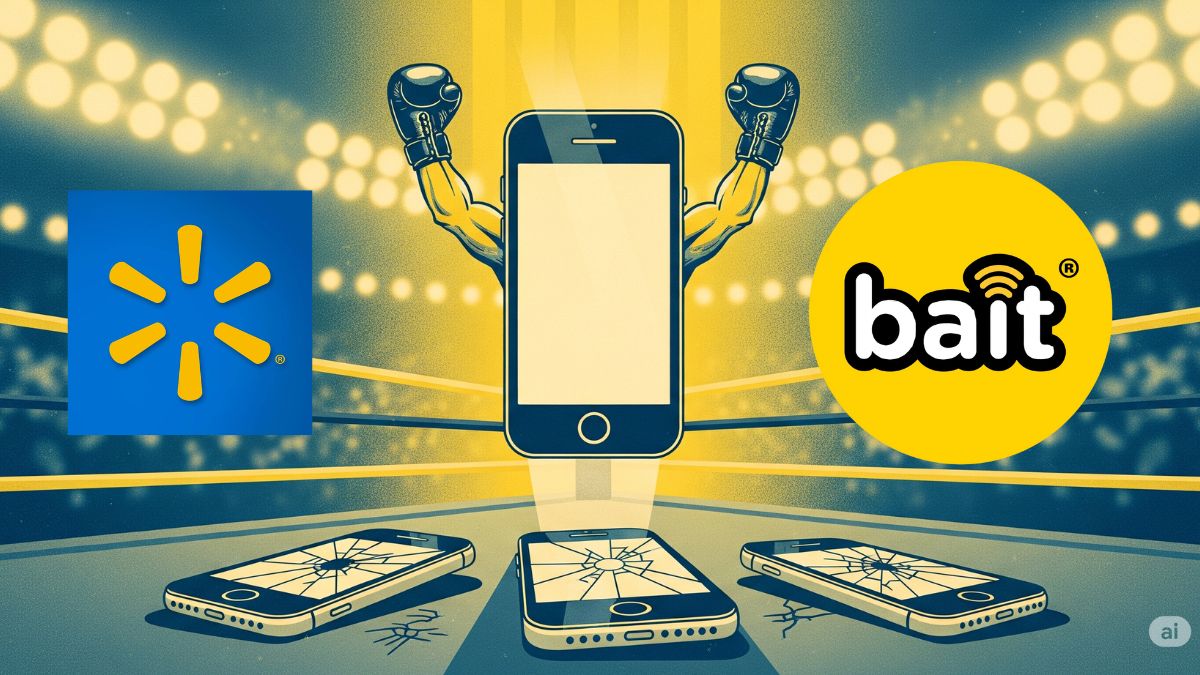
The telecommunications industry in Mexico is undergoing a moment of deep transformation. While historical players like AT&T and Telefónica (Movistar) consider exiting the country, a new brand has managed to consolidate itself: Bait, the mobile phone service from Walmart de México y Centroamérica. With a model focused on low prices and massive access, Bait has grown rapidly in just five years. The question is: could Bait be an alternative to Telcel, the giant owned by Carlos Slim Helú, The richest man in Mexico and telecommunications magnate in Latin America? Here’s what the data shows.
READ ALSO: What are Walmart’s new mobile stores like? We’ll tell you
How big is Bait in mobile telephony?
Since its launch in 2020, Bait has built a solid foundation in the mobile sector. According to Walmart data, the company has:
- More than 21.5 million active users
- Presence in 135,000 locations
- 3,400 sales points
- 1.2 million recharge points
- And 15 Bait Experience Centers that enable connectivity in both urban and rural areas
With this infrastructure, Bait is positioned as the largest MVNO (Mobile Virtual Network Operator) in Mexico, far surpassing other independent players.
What does Bait’s new postpaid service offer?
As part of its fifth anniversary, Bait launched its postpaid mobile phone service, expanding beyond prepaid and home mobile internet. The expansion aligns with Walmart’s goal to “help Mexican families save money and live better,” according to Beatriz Núñez, Senior Vice President of Growth for Walmart de México y Centroamérica.
“We are very happy to celebrate five years of connecting people and sharing the benefits of connectivity,” said Núñez. “With the entry into the postpaid segment… we add benefits that provide our customers greater value for their money and a comprehensive experience within our Walmart ecosystem.”
The new postpaid plans include:
- $249 Plan: in-person and telemedicine consultations, with discounts at pharmacies and clinics.
- $289 Plan: includes the above, plus Walmart Pass with free delivery in 60 minutes.
- $339 Plan: adds Sam’s Benefits membership, with club discounts and deals on food and entertainment.
These prices will remain throughout 2025, with moderate increases expected starting in 2026.
Bait: this is how it’s challenging Telcel and AT&T
According to a report from OpenSignal, Bait has attracted millions of Mexican users with a mobile experience that “prioritizes value.” Even though its average download speed (14.6 Mbps) is lower than that of Telcel and AT&T (38 Mbps), it offers significant advantages:
- Upload performance superior to major carriers
- Signal availability nearly identical
- Only 6% lower overall reliability
- Price per GB is less than half of what Telcel and AT&T charge
“At half the price, but only a 10% difference in mobile experience across many metrics, it’s clear why BAIT has been an attractive option for many consumers,” the report concludes.
Where has Bait been most successful in Mexico?
Bait’s growth has been especially notable in price-sensitive regions. According to OpenSignal, “Its win share… is higher in southern states like Chiapas, the poorest in Mexico.” The company also holds a “wins per loss” (WPL) ratio of 1.3, higher than Telcel and AT&T combined (0.8). In other words, for every user lost, it gains more than one new subscriber.
Walmart, the key to Bait’s strategy
Walmart’s synergy is crucial. Bait’s presence in physical stores allows users to buy and recharge their services during their regular shopping. “This integration streamlines customer acquisition costs… and allows a focus on aggressive subscriber growth instead of short-term revenue,” states the OpenSignal report.
Walmart’s financial and logistical backing has also enabled Bait to maintain low prices and absorb higher operating costs, such as the recent increase in wholesale rates by Altán Redes, its infrastructure provider.
What is Altán Redes?
ALTAN Redes is a Mexican telecommunications company that operates the Red Compartida, a wholesale mobile telephone network. This means that ALTAN does not sell services directly to the public, but rather leases its infrastructure to other telecommunications companies, known as Mobile Virtual Network Operators (MVNOs), so that they can offer their own data, voice, and messaging plans to end users.
The Red Compartida was created as a project of the Mexican government with the goal of fostering competition in the telecommunications market and bringing internet and mobile telephone services to areas that previously had no coverage. This network uses the 700 MHz band, a frequency that allows for broad coverage and improved indoor signal penetration.
What is the relationship between Bait and Altán Redes?
The relationship between Bait and Altán Redes is complex. On the one hand, Altán is the strategic partner that allows Bait to operate without deploying its own network. In fact, 80% of Altán’s revenue comes from Bait. However, this also presents a risk. “The idea of launching a direct retail business has been under consideration for some time… If this were to proceed, it would undermine BAIT’s value proposition by offering identical, if not better, prices and speeds,” warns OpenSignal. If Altán decides to compete directly, Walmart may be forced to rely solely on its distribution network to differentiate.
Currently, Altán Redes lacks the capability to offer 5G services, limiting Bait’s ambitions in the postpaid segment. According to the report: “The most likely path would be to offer a 5G service to support its postpaid ambition.”
Although Altán has run tests in the 2.5 GHz band and expressed interest in acquiring spectrum, it still lacks the necessary infrastructure. This could slow down Bait’s evolution—especially if it wants to compete with Telcel, which already offers widespread 5G coverage in major Mexican cities.
Bait’s explosive growth has been made possible by a clear value proposition: low cost, acceptable connectivity, and massive physical presence. But maintaining that growth will require more than low prices.
According to OpenSignal: “It is likely that the most price-sensitive consumers are already on board… To keep growing, BAIT will have to offer more than low prices: it must also meet users’ growing expectations.” Without 5G capability and facing potential competition from Altán Redes, the challenge will be to remain competitive in an evolving market.
If you’d like to read the full OpenSignal report, click this link.










